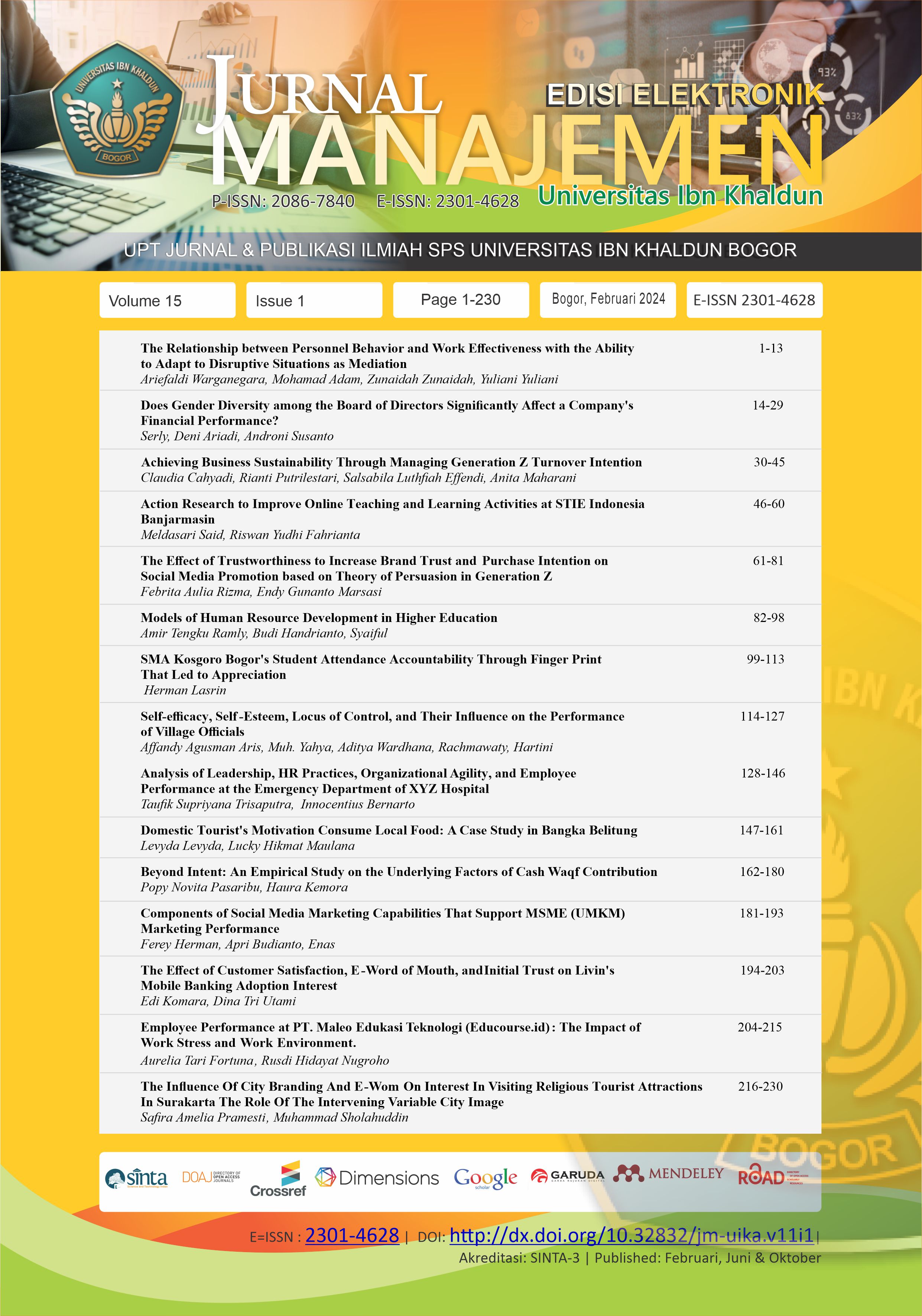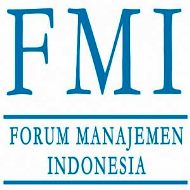Achieving Business Sustainability Through Managing Generations Z Turnover Intention
DOI:
https://doi.org/10.32832/jm-uika.v15i1.15080Keywords:
Turnover, Intention, GenerationAbstract
This study aimed to determine the effect of employer brand equity, employment development system, and work environment towards job satisfaction which affects employee turnover intention. This research used a quantitative approach method, and the sample was taken by using a convenient sampling method with individuals as the unit of analysis who are Generation Z with birth years above 1997 and who already have work activities in the city of Jakarta and its surroundings. Data collection had done online using Google Forms and resulted in 253 responses that could be used. The result showed that all of the hypotheses were rejected. The result obtained from this study are expected to benefit company management in analyzing and mapping the level of job satisfaction, workplace spirituality, and organizational citizenship behaviour for employee performance.
References
Agbozo, G. K., Owusu, I. S., Hoedoafia, M. A., & Atakorah, Y. B. (2017). The effect of work environment on job satisfaction: Evidence from the banking sector in Ghana. Journal of human resource management, 5(1), 12-18.
Alam, A., & Asim, M. (2019). Relationship between job satisfaction and turnover intention. International Journal of Human Resource Studies, 9(2), 163. https://doi.org/10.5296/ijhrs.v9i2.14618
Alshathry, S., Clarke, M., & Goodman, S. (2017). The role of Employer Brand Equity in employee attraction and retention: A unified framework. International Journal of Organizational Analysis, 25(3), 413–431. https://doi.org/10.1108/ijoa-05-2016-1025
Backhaus, K., & Tikoo, S. (2004). Conceptualizing and researching employer branding. Career Development International, 9(5), 501–517. https://doi.org/10.1108/13620430410550754
Badrianto, Y., & Ekhsan, M. (2020). Effect of work environment and job satisfaction on employee performance in pt. Nesinak industries. Journal of Business, Management, & Accounting, 2(1).
Basnyat, S., & Clarence Lao, C. S. (2019). Employees’ perceptions on the relationship between human resource management practices and employee turnover. Employee Relations: The International Journal, 42(2), 453–470. https://doi.org/10.1108/er-04-2019-0182
Benraïss-Noailles, L., & Viot, C. (2020). Employer brand equity effects on employees well-being and loyalty. Journal of Business Research, 126, 605–613. https://doi.org/10.1016/j.jbusres.2020.02.002
Busari, A. H., Mughal, Y. H., Khan, S. N., Rasool, S., & Kiyani, A. A. (2017, April 10). Analytical cognitive style moderation on promotion and turnover intention. Journal of Management Development. Retrieved February 24, 2023, from https://doi.org/10.1108/JMD-12-2015-0184
Bussing, A., Bissels, T., Fuchs, V., & Perrari, K.-M. (1999). A dynamic model of work satisfaction: Qualitative approaches. Human Relations, 52, 999–1028. https://doi.org/10.1177/001872679905200802.
Chhabra, N. L., & Sharma, S. (2014, March 4). Employer branding: Strategy for improving employer attractiveness. International Journal of Organizational Analysis. Retrieved February 24, 2023, from https://doi.org/10.1108/IJOA-09-2011-0513
Choo, S., & Bowley, C. (2007). Using training and development to affect job satisfaction within franchising. Journal of Small Business and Enterprise Development, 14(2), 339–352. doi:10.1108/14626000710746745
Cranny, C., Smith, P. & Stone, E. (Eds.). (1992). Job satisfaction: How people feel about their jobs and how it affects their performance. New York: Lexington Books.
Franca, V., & Pahor, M. (2012). The strength of the employer brand: Influences and implications for recruiting. Journal of Marketing & Management, 3(1), 78–122.
Gerbman, R. V. (2000), Corporate universities 101, HR Magazine, 45, 2, 101–6
Hair, J. F., Risher, J. J., Sarstedt, M., & Ringle, C. M. (2019). When to use and how to report the results of PLS-SEM. European business review, 31(1), 2-24.
Juhdi, N., Pa'wan, F., & Hansaram, R. M. K. (2013, February 7). HR practices and turnover intention: The mediating roles of organizational commitment and organizational engagement in a selected region in Malaysia. Taylor & Francis. Retrieved February 24, 2023, from https://www.tandfonline.com/doi/full/10.1080/09585192.2013.763841
Kurniawaty, K., Ramly, M., & Ramlawati, R. (2019). The effect of work environment, stress, and job satisfaction on employee turnover intention. Management science letters, 9(6), 877-886.
Latif, A. and Abideen, Z. (2012), ‘Does it really matter? Training and development in telecom sector of Pakistan’, American Journal of Scientific Research, 79, 24–39.
Lestari, D., & Margaretha, M. (1970, January 1). Work life balance, job engagement and turnover intention: Experience from Y Generation Employees. Management Science Letters. Retrieved February 24, 2023, from http://m.growingscience.com/beta/msl/4183-work-life-balance-job-engagement-and-turnover-intention-experience-from-y-generation-employees.html
Lin, C.-P., Tsai, Y.-H., & Mahatma, F. (2017, November 6). Understanding turnover intention in cross-country business management. Personnel Review. Retrieved February 24, 2023, from https://doi.org/10.1108/PR-07-2016-0176
Logan, J. K. (2000), ‘Retention tangibles and intangibles: more meaning in work is essential, butgood chair massages won’t hurt’, Training and Development, 54, 4, 48–50.
Mahoney, A. (2015). Commitment and employee development: Comparing generations X and Y. SJSU ScholarWorks. Retrieved February 24, 2023, from https://doi.org/10.31979/etd.q39n-h7vz
Noailles, L. B., & Viot, C. (2020, February 17). Employer brand equity effects on employees well-being and loyalty. Journal of Business Research. Retrieved February 24, 2023, from https://www.sciencedirect.com/science/article/abs/pii/S0148296320300862
Nunn, J. (2000), ‘Career planning key to employee retention’, Journal of Property Management,65,5, 20–1
Rachmawati, D. (2019). Welcoming gen Z in job world (selamat Datang Generasi Z di dunia kerja). Proceeding Indonesian Carrier Center Network (ICCN) Summit 2019. Retrieved February 24, 2023, from https://ocs.unmul.ac.id/index.php/ICCN/article/view/2721
Rani, N., & Samuel, A. (2016, December 12). A study on generational differences in work values and person-organization fit and its effect on turnover intention of generation Y in India. Management Research Review. Retrieved February 24, 2023, from https://www.emerald.com/insight/content/doi/10.1108/MRR-10-2015-0249/full/html
Spector, P. (1996). Industrial and organizational psychology: research and practice. New York: John Wiley.
Tjan, C., Joe, J., Go, E. D., Santoso, S., Chauhan, S., Endacott, P., Chandra, R., Ng, C. G., Nahar, I., Yin, T., Alika, F., Thirza, A., & Gunawan, C. (2022). Asean grow and Scale Talent playbook - southeast asia - kearney. Southeast Asia. Retrieved February 24, 2023, from https://www.southeast-asia.kearney.com/digital/asean-grow-and-scale-talent-playbook
Downloads
Published
How to Cite
Issue
Section
License
Copyright (c) 2024 Jurnal Manajemen (Edisi Elektronik)

This work is licensed under a Creative Commons Attribution-NonCommercial 4.0 International License.
Authors who publish with this journal agree to the following terms:
- Authors retain copyright and grant the journal right of first publication with the work simultaneously licensed under a Creative Commons Attribution-NonCommercial-ShareAlike 4.0 International License that allows others to share the work with an acknowledgement of the work's authorship and initial publication in this journal.
- Authors can enter into separate, additional contractual arrangements for the non-exclusive distribution of the journal's published version of the work (e.g., post it to an institutional repository or publish it in a book), with an acknowledgement of its initial publication in this journal.
- Authors are permitted and encouraged to post their work online (e.g., in institutional repositories or on their website) prior to and during the submission process, as it can lead to productive exchanges, as well as earlier and greater citation of published work (See The Effect of Open Access).











